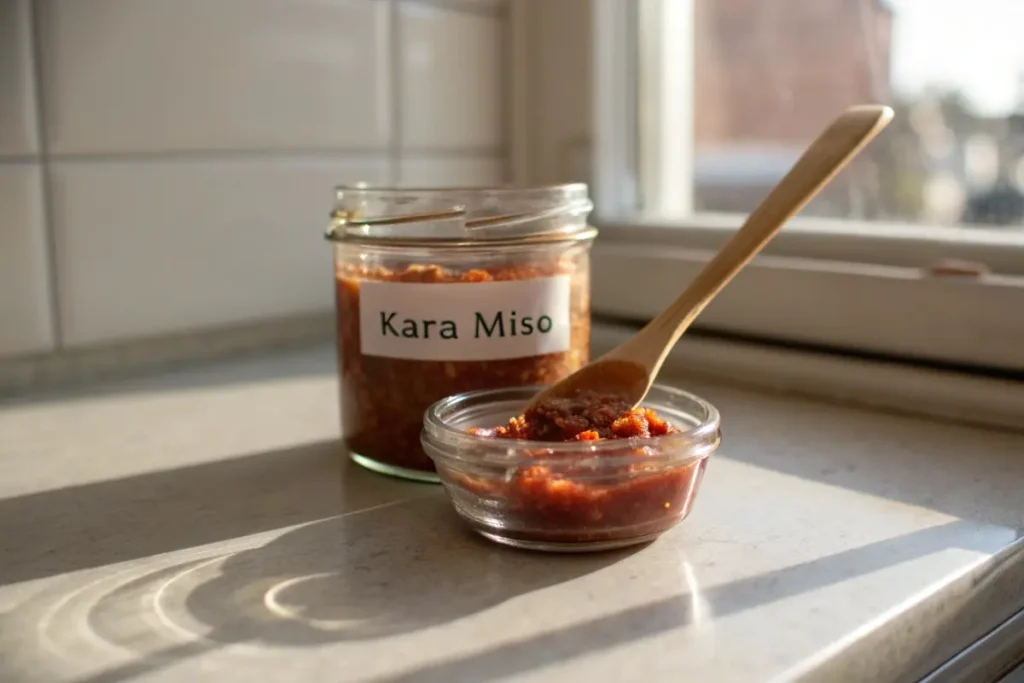If you’re looking to add a bolder punch to your Japanese cooking, kara miso might just be the lively ingredient you need. Within the first spoonful, you’ll notice its underlying umami from fermented soybeans, amplified by a warming layer of spice that sets it apart from milder aramiso or classic miso varieties. Whether you love building depth in ramen broth, marinating proteins for grilling, or simply adding a kick to your favorite soups, kara miso is versatile enough to become a pantry staple. But what exactly is kara miso? And how does it differ from tonkotsu-based soups or other types of fermented soybean pastes? This article dives into the heart of kara miso, exploring its flavor profile, different ingredient blends, tips on using it in home cooking, and the cultural significance behind its pungent allure.
For those curious about stepping up their healthy Japanese recipes, or exploring more intense flavors in their daily meals, understanding the nuances of kara miso can open up a world of culinary creativity. If you’ve been wondering why is miso so expensive, or whether tonkotsu vs miso is the right choice for your ramen, read on. By unraveling the robust background of kara miso and looking at real-life cooking examples, you’ll see why this pungent, sometimes fiery soybean paste has held its ground in traditional Japanese kitchens for centuries—while still evolving to suit modern, global palates. For a balanced meal that harnesses the savory depth of kara miso, consider pairing a miso-based soup with other staples like our Japanese Chicken Fried Rice Recipe for a complete, flavor-packed dinner.
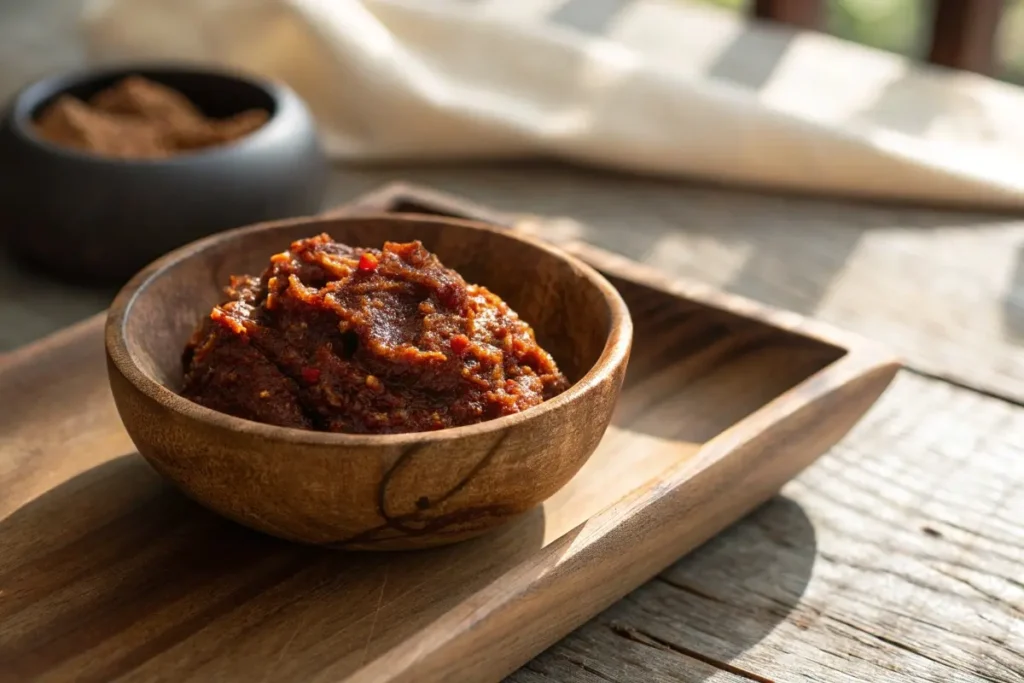
Table of Contents
What Is Kara Miso?
Kara Miso’s Distinctive Qualities
Kara miso translates loosely to “spicy miso” in English. Traditional miso is made from fermented soybeans (often combined with rice or barley), which yields a creamy paste loaded with savory umami. In the case of kara miso, chili peppers or chili paste are introduced during or after fermentation, creating a sharper, bolder taste. This sets it apart from milder miso pastes like shiro miso (white) or aka miso (red). The result? A layered, sweet-savory paste with an undeniable warmth.
Why the Spice?
Spice has historically played multiple roles in Japanese cuisine: from stimulating appetite to preserving foods. Adding chili or chili paste into miso taps into these traditions while also catering to the modern palate that craves heat. Depending on brand and region, the level of spiciness can vary widely—from mild tingles to a tongue-numbing burn.
Common Ingredients in Kara Miso
- Fermented Soybeans: The heart of miso. This fermentation fosters beneficial enzymes, probiotics, and the essential umami base.
- Koji (Rice or Barley): Typically used to accelerate and deepen fermentation. Koji’s enzymes break down proteins and starches, enriching flavor.
- Chili Peppers: May come in dried, powdered, or fresh forms. Sometimes a chili paste is stirred in for uniform spice distribution.
- Salt & Seasonings: Miso inherently requires salt for both preservation and fermentation. Additional flavor enhancers, like sake or dashi essence, might appear in some recipes.
Flavor vs. Other Miso Variants
- Shiro Miso: Light, sweet, lower salt. Excellent for subtle soups or dressings.
- Aka Miso: Darker, stronger, more robust. Lends complexity to hearty stews.
- Aramiso: Another type sometimes referred to as a “rough” or “coarsely textured” miso.
- Kara Miso: A specialized subcategory that builds upon an existing miso base but spikes it with chili heat.
Kara Miso in Ramen
One popular usage: kara miso ramen, featuring a spicy miso broth. This soup often highlights an intense flavor depth balanced by noodles, vegetables, and sometimes proteins like ground pork or tofu. The spiciness can be dialed up or down according to preference. For those exploring a toned-down version, adding fresh cream or sesame paste can soften the heat while maintaining that fundamental miso tang.
Where to Buy & How to Store
Specialty Asian groceries often stock kara miso, but you can also find it online or in well-stocked supermarkets. Always check the packaging for the heat level, as different brands vary. After opening, keep kara miso refrigerated in a sealed container. Properly stored, it remains fresh for months, though flavor intensity can evolve over time. Remember: a high-quality kara miso paste can liven up numerous dishes beyond just soup—try it in stir-fries, marinades, or as a finishing condiment for grilled fish. If you’d like to experiment with pairing it in other creative ways, see our Japanese Vegan Recipes for plant-forward ideas that can incorporate spiced miso for a pleasing kick.
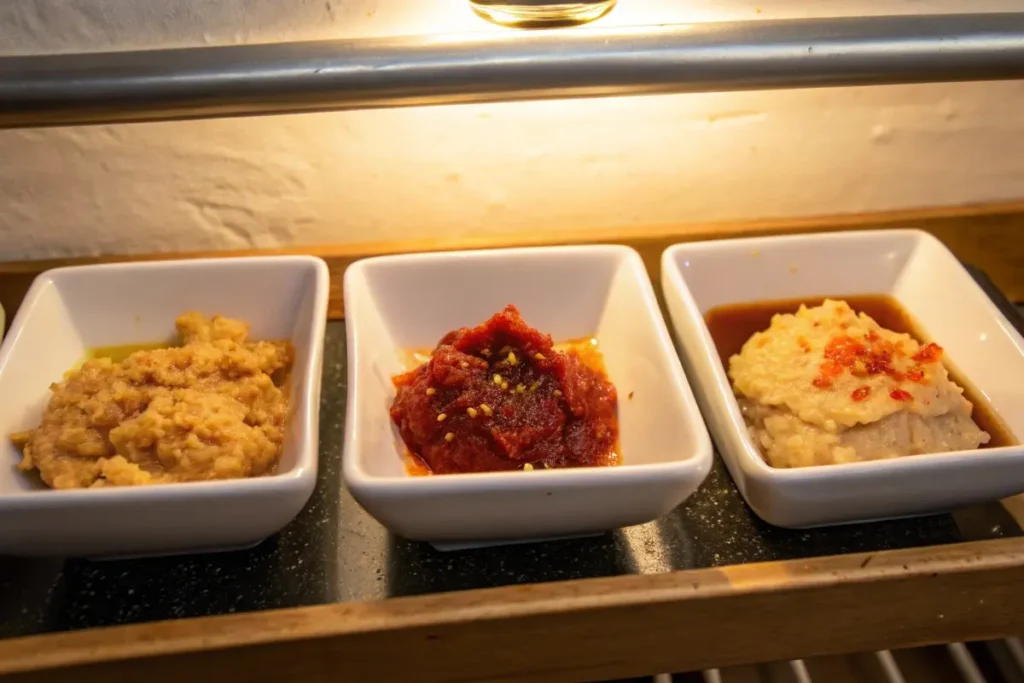
Ingredients and Culinary Uses
Key Ingredients in Kara Miso
- Soybeans: Typically steamed or boiled, then mixed with koji and salt.
- Koji: A fungus (Aspergillus oryzae) grown on grains like rice or barley, fueling fermentation.
- Chili: The defining factor of “kara.” This could be red chili pepper powder, chili paste, or even combined spices.
- Salt: Controls fermentation rate, preserving the mixture.
Some artisanal makers might add unique local seasonings or sweeteners (like sugar, honey, or mirin) to balance spiciness. Meanwhile, commercial blends often use a standardized chili content to suit broad tastes. If you’re unsure about heat levels, start with a mild brand and gradually explore spicier versions.
Popular Culinary Uses
- Soups & Stews: Incorporating a dollop of kara miso into broths yields immediate depth, perfect for ramen or hearty winter soups.
- Marinades: Mix with soy sauce, mirin, or sake to marinate chicken, pork, or tofu. The chili adds heat, while the fermented base tenderizes and enriches.
- Sauces & Dressings: For a zesty salad dressing, blend kara miso with sesame oil, vinegar, and a dash of sweetener. Or drizzle a miso-chili sauce over grilled vegetables.
- Glazes: Baste fish fillets or eggplants with a sweet-spicy miso glaze, then broil until caramelized.
- Condiment: Try a small spoonful on the side of your plate. Miso, especially spicy miso, can accent noodles, dumplings, or even sushi bites.
Pairing Suggestions
Proteins
- Chicken or Pork: The heavier flavors of red meat or poultry match well with spiciness. Kara miso marinade ensures a succulent outcome.
- Tofu or Tempeh: Absorbs miso’s intensity, ideal for vegetarian or vegan dishes.
- Seafood: White fish or shellfish can be elevated by the robust tang of chili-laced miso.
Vegetables
- Eggplant: Known in Japanese cuisine as nasu dengaku, eggplant halved, scored, and topped with miso-based sauce. Using kara miso spices it up.
- Mushrooms: Earthy fungi accent miso’s umami. Sauté mushrooms with a spoonful of kara miso for a savory side.
- Leafy Greens: Spinach, bok choy, or kale lightly dressed in spicy miso sauce = bright, nutrient-packed salads.
Creative Twists
- Kara Miso Butter: Whip softened butter with a small spoonful of kara miso. Spread on bread, swirl into mashed potatoes, or top a grilled steak for a fiery twist.
- Kara Miso Aioli: Blend mayonnaise, garlic, and kara miso for an addictive sandwich spread or dip.
- Miso Hot Pot: Throw in extra chili miso for a kimchi jjigae-like vibe, bridging Japanese-Korean flavors in one pot.
Tonkotsu vs. Miso: A Quick Ramen Comparison
While tonkotsu refers to a pork-bone-based broth (rich, milky in appearance), miso ramen leans on fermented soybean paste for that distinct savory flavor. If you’re deciding between the two, think about your preferred mouthfeel: tonkotsu ramen is heavier with collagen from pork bones, whereas miso ramen, especially kara miso ramen, offers a punchy, spiced flair with a hearty, bean-based body. Some ramen shops even blend tonkotsu with spicy miso for a “best-of-both-worlds” approach.
For a spin on side dishes that might pair well with your spicy miso marinade, try our Vegetables Japanese Recipe for a crunchy, seasonal accompaniment. Miso-laced vegetables complement the heat in kara miso-based main dishes, balancing your overall meal.
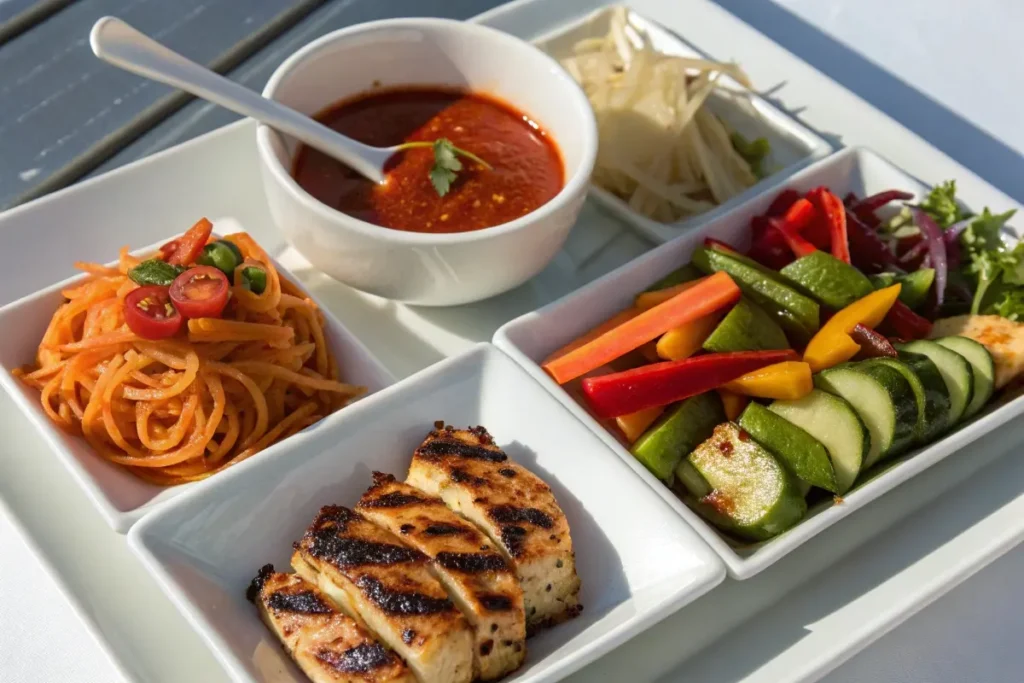
History and Context
Early Miso Origins
Miso’s roots trace back centuries in Japan, with evidence suggesting it was influenced by Chinese fermented bean pastes. Over time, the Japanese refined the process, adjusting grains, salt content, and fermentation lengths. Miso became a staple in temple cuisine, shojin ryori, and eventually mainstream households. The paste’s ability to preserve proteins in the pre-refrigeration era contributed to its widespread popularity.
Emergence of Spicy Variants
Spiciness in Japanese cooking historically took a backseat to subtler flavors like dashi or soy sauce. Chili peppers arrived in Japan around the 16th century via Portuguese traders. Over the next few centuries, chili made sporadic appearances in certain regions, though never overshadowing mainstream preferences. Eventually, mixing chili into miso became a small-scale practice among communities who favored punchier tastes. This approach spread regionally—leading to distinct local versions of “spicy miso.”
Kara Miso’s Rise
In the modern era, especially as global palates developed a love for hot sauces and peppers, Japan saw a resurgence of chili-infused foods. “Kara miso” capitalized on this wave. Certain ramen shops popularized kara miso ramen, appealing to younger diners who craved something more intense than the usual mild miso. With the wave of “ramen mania” in the 1980s and 1990s, specialized shops boasting “fiery miso broths” popped up in urban centers like Tokyo and Sapporo, fueling the concept’s expansion.
Variation by Region
Regional differences remain: in Hokkaido, for instance, miso ramen already had a robust presence. Adding chili simply magnified the boldness. In Kyushu, known for tonkotsu ramen, spicy miso was occasionally blended with pork-bone-based soups. Now, you’ll find kara miso integrated not just in ramen but also in homemade marinades, sauces, and condiments across Japan. The popularity of Korean and Sichuan cuisines also influenced Japanese consumers to appreciate spicier profiles, bridging cross-cultural culinary exploration.
Modern Popularity & Global Adaptation
Today, kara miso is widely recognized internationally among Japanese cuisine enthusiasts. With the global fascination for spicy condiments—Sriracha, gochujang, harissa—it’s no surprise kara miso found its place in fusion dishes and modern recipes. Chefs worldwide incorporate it to add complexity to vegan stews or to craft unique chili-laden salad dressings. And for those who wonder, “What is kara miso?” the simplest answer: it’s a result of centuries-old Japanese fermentation, enriched by the warmth of chili—perfect for the modern palate that embraces both tradition and spice.
If you’re intrigued by how other classic Japanese flavors adapt to contemporary cooking, see our Japanese Curry Recipe One Piece for an example of cultural fusion. Kara miso stands parallel as a testament to how Japan’s culinary tradition can continuously evolve while retaining its core identity.
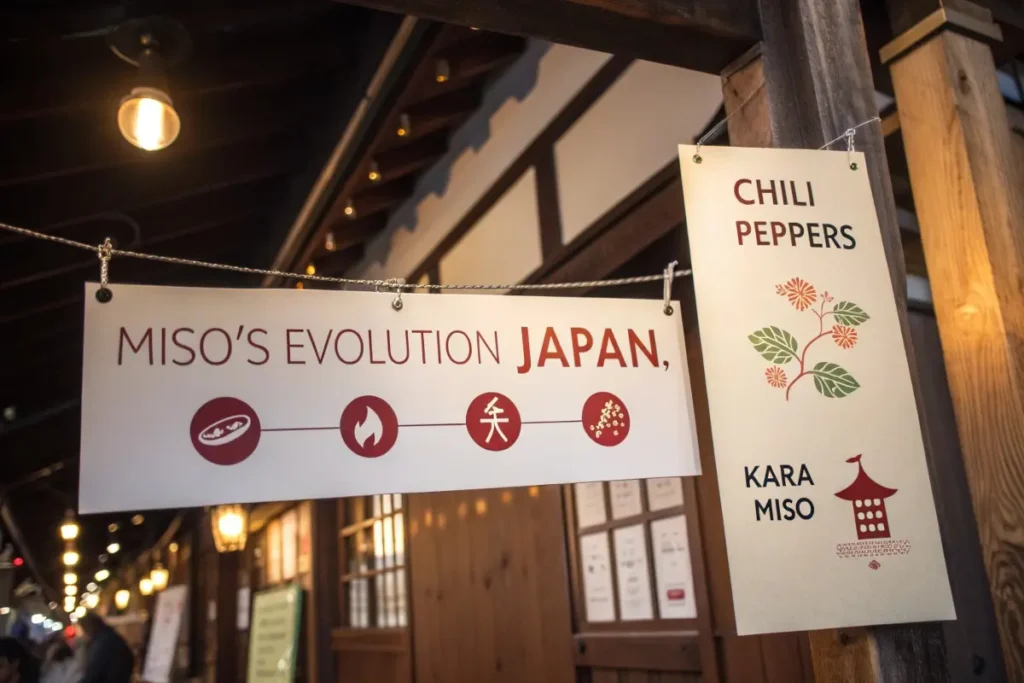
Practical Examples/Use Cases
1. Kara Miso Ramen Feast
A popular scenario: cooking kara miso ramen at home. Start with a robust chicken or vegetable stock. Stir in a spoonful (or more) of kara miso. Top with bean sprouts, sliced pork or tofu, half a boiled egg, and chopped scallions. The result? A warming, savory bowl that’s spicier than standard miso ramen. If you want to lean into a heartier meal, serve it with a side of our Japanese Fried Rice Recipe to enjoy complementary textures and flavors.
2. Spicy Miso Marinade
For grilled or baked fish, whisk together kara miso, soy sauce, and a splash of sake. Marinate salmon fillets for at least 30 minutes, then roast or grill until the glaze caramelizes. The chili element elevates the natural richness of salmon, transforming an ordinary dinner into something gourmet.
3. Stir-Fry Booster
Tired of bland vegetables? Add a tablespoon of kara miso to your wok, along with a pinch of sugar or honey to balance the spice. Toss in carrots, bell peppers, mushrooms, or any leftover produce. The result is a luscious, thick sauce that coats each vegetable, delivering a savory, spicy punch.
4. Fusion Tacos or Wraps
Kara miso adapts easily to global fusion recipes. Spread a thin layer on tortillas, then fill with grilled chicken or mushrooms, shredded cabbage, and a drizzle of sesame dressing. This East-meets-West approach proves that kara miso can stand in for many typical hot sauces or salsas, offering deeper umami notes.
5. Party Dips
For a simple appetizer, combine kara miso with cream cheese or mayonnaise and fresh herbs. Serve with raw veggies or breadsticks. The chili-laced miso brings a unique dimension, ensuring your guests keep dipping for more.
Whether you’re cooking a full Japanese meal or sprinkling it into a global dish, kara miso has countless use cases. If you’re short on time but need a big flavor boost, a mere teaspoon stirred into your sauce or soup can do wonders. And if you’re on the hunt for additional hearty, spiced recipes, check out the Best Japanese Foods guide for curated highlights of Japan’s most iconic dishes, many of which can be adapted with a bit of spicy miso flare.

FAQs
1. What is kara miso?
Kara miso refers to a type of Japanese fermented soybean paste blended with chili or chili paste, imparting a spicy kick. It maintains the foundational umami of regular miso but packs extra heat.
2. What are the ingredients in kara miso?
Typically, kara miso consists of soybeans, salt, koji (often rice-based), and chili peppers or chili paste. Some varieties include added sweeteners or flavor enhancers, but the spice element remains the defining trait.
3. What is tonkotsu vs miso in ramen context?
Tonkotsu ramen relies on a pork-bone broth that’s creamy, opaque, and rich in collagen, whereas miso ramen uses fermented soybean paste for a savory, often slightly sweet or tangy broth. When made with kara miso, the latter becomes spicier and more robust in flavor.
4. Why is miso so expensive sometimes?
High-quality miso undergoes a lengthy fermentation process—sometimes months or years. Factors such as premium soybeans, artisanal production, and careful aging can drive up costs. Imported miso might also have additional shipping and handling fees.
5. How do I store kara miso?
Refrigerate it after opening. Kept sealed and chilled, kara miso can last for months. A slight color or flavor shift over time is normal due to ongoing fermentation, but it remains safe to consume.
6. Is kara miso suitable for vegetarians or vegans?
Yes, unless a brand includes fish-based dashi or other animal additives. Always check the label to confirm. Most plain miso pastes, including spiced versions, are soy-based and naturally vegan-friendly.
7. Can I make my own kara miso?
Yes—by mixing your preferred miso (white or red) with chili powder or chili paste. You can also ferment from scratch, adding chili at the right stage, though home fermentation requires precise temperature control and patience.
8. Is kara miso always super spicy?
Heat levels vary by brand and style. Some are mildly piquant, while others can be very hot. To adjust spiciness, you can blend in a milder miso or add sweeteners (like mirin or sugar) to tone down the chili.
If you still have more questions about miso-related dishes, consider browsing Japanese Dessert Recipes to see how sweet or savory miso accents might appear in unexpected ways. Culinary creativity with miso truly knows no bounds.
Conclusion
Whether you’re new to Japanese cuisine or a seasoned miso enthusiast, kara miso offers a fiery spin on classic fermentation. Bridging the comforting familiarity of miso with a bold chili kick, it stands as a testimony to how tradition can adapt to evolving tastes. In many kitchens, it has become a secret weapon, enlivening everything from soups and marinades to dips and sauces.
If you’re torn between tonkotsu vs miso for your next ramen, or you’ve wondered if miso’s cost is justified, exploring kara miso can reveal the depth and versatility hidden behind each jar. A single spoonful can turn a bland meal into a flavor-packed feast. With months of shelf life in your fridge, it’s easy to incorporate spicy miso into weekly cooking routines—especially if you seek that sweet spot of umami plus chili heat. From marinade bases to daily soups, kara miso can easily become the star of your repertoire. For an even broader exploration of Japanese delicacies, including ramen variations and beyond, check out our curated Japanese Recipes to continue expanding your culinary horizon. Ultimately, whether you savor it in ramen, spread it on grilled fish, or fuse it into Western-style dips, kara miso stands ready to redefine your idea of spicy, savory, and deeply satisfying cuisine.
